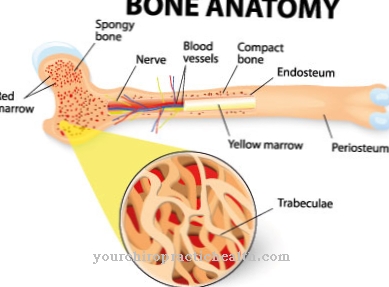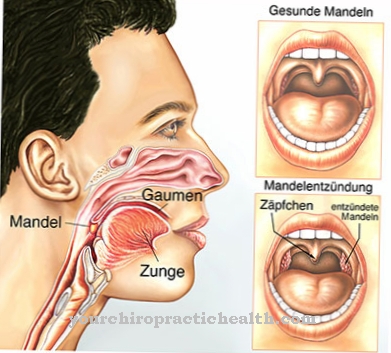Polyneuropathy is a disorder in the peripheral nervous system in which the nerves no longer properly transmit incoming stimuli to the brain. Parasitic sensations and pain arise. Polyneuropathy is often triggered by one or more underlying diseases.
What is polyneuropathy?

© Bernhard Schmerl - stock.adobe.com
The Polyneuropathy is a disease of the peripheral (peripheral) nervous system (PNS). Peripheral nerves are the nerves that do not belong to the central nervous system (CNS), which is located in the brain and spinal cord.
The peripheral nerves begin when they exit the spine and branch out further and further in the body until they finally reach the muscles and skin in thin branches. A distinction is made between motor and sensory nerves. The motor nerves are responsible for movements, the sensory for feeling in and on the body.
In polyneuropathy, the transmission of stimuli from the body to the brain is disturbed. The prefix "poly" means that many nerves are affected by the disease at the same time, "neuro" means "affecting the nerves" and "pathie" is the technical term for "disease". The polyneuropathy can occur in different forms and is a common nerve disease.
causes
To date there are about 200 possible causes for that Polyneuropathy known. A distinction is made between congenital and acquired polyneuropathy.The congenital form is relatively rare. It can be caused, for example, by a congenital disorder of the nerve conduction velocity or by an inherited enzyme defect.
Acquired polyneuropathy is far more common than the congenital form and is usually triggered by certain underlying diseases. The most common causes are diabetes (diabetes mellitus) and alcoholism (chronic alcohol abuse). In diabetes, the disturbed sugar metabolism leads to an undersupply and damage to the finely branched nerves.
In alcoholism, the disorder occurs due to the toxic effects of alcohol. Medicines or toxic substances such as arsenic or lead can also cause toxic polyneuropathy. Other possible causes of polyneuropathy are kidney disease and long-term dialysis. In rare cases, tumors, infections or deficiency diseases can also trigger polyneuropathy.
Symptoms, ailments & signs
The disease can cause several different complaints, depending on whether sensitive, motor or autonomic nerve fibers are affected. If sensitive nerves are damaged, the perception in the arms and legs decreases. It usually starts with the toes or fingers. You start to tingle; in the further course there are burning and stabbing pains.
The patient has the feeling that toes or fingers are swollen, although this is not actually the case. The sensation of temperature and pain deteriorates, which leads to an increased risk of injury. Patients could get burned or injured without realizing it. If motor nerves are affected, this is indicated by a loss of strength in the corresponding muscles.
Muscle cramps can also occur, and leg cramps are very common at night. Paralysis is also possible and muscle wasting can occur as a result. If the disease causes disorders of the autonomic nerves, it can be life-threatening. Autonomous nerves supply organs such as the intestines, heart or lungs.
If damaged, the organ in question no longer functions. If the colon is affected, diarrhea or constipation can result. It can also be difficult to empty your bladder and impotence is possible. If the disturbances are in the nerves of the heart muscle, this causes cardiac arrhythmias or fluctuations in blood pressure. If the nerve conduction of the lungs is disturbed, in extreme cases respiratory arrest can occur.
Diagnosis & course
The symptoms of the acquired Polyneuropathy are very diverse and occur in different forms. Perception disorders in the arms and legs are typical, with the legs being affected more often than the arms. Patients feel a tingling sensation in their limbs, as if they had "fallen asleep," and can no longer perceive heat and pressure, which can lead to burns and other injuries.
Nocturnal calf cramps, burning pains in the feet, muscle twitching and restless legs are also typical. If the autonomic nervous system is also affected by the polyneuropathy, functional disorders in the organs can occur. Congenital polyneuropathy often leads to symptoms of paralysis, gait disorders and visual impairments that can lead to blindness.
The diagnosis is made based on the patient's symptoms and medical history. The functionality of the nerves and muscles is checked with a neurological examination. In addition, if polyneuropathy is suspected, the nerve conduction velocity is measured using electroneurography. A blood test can detect infections or detect toxic (poisonous) substances in the blood.
Complications
As a result of the polyneuropathy, those affected suffer from severe pain and also from various abnormal sensations. As a rule, however, the further course of the disease depends heavily on the underlying disease, so that a general course cannot be predicted. The patients suffer primarily from sensitivity disorders or paralysis.
Pain in the legs or arms can also occur and lead to restricted mobility and other difficulties in everyday life. There is also a typical tingling sensation or cramps. The pain is often burning. Muscle twitching also occurs and muscle weakness continues. The patients themselves often feel irritated due to the permanent pain and suffer from a significantly reduced quality of life.
Gait disorders and disorders of coordination can also occur due to polyneuropathy. The eyesight is also not infrequently impaired by the disease, so that in the worst case, those affected can go completely blind. The treatment of polyneuropathy depends on the underlying disease. As a rule, however, the symptoms and symptoms of this disease can be limited.
When should you go to the doctor?
A tingling sensation in the arms or legs is considered a sign of an existing irregularity. If the symptoms occur temporarily, in most cases there is a circulatory disorder due to an unfavorable posture. If complete freedom from symptoms sets in within a short period of time, no doctor is normally required. If the sensitivity disturbances increase in intensity or extent, a doctor should be consulted. A visit to a doctor is also recommended for recurring symptoms. Additional pain or loss of muscle strength is worrying.
In the event of paralysis or impaired locomotion, the person concerned needs help. If there are restrictions in general mobility, sporting activities can no longer be carried out or if there is an internal weakness, a doctor should be consulted. In the case of disorders of the heart rhythm, an increased heartbeat as well as dizziness and unsteady gait, it is advisable to clarify the symptoms. If the person concerned suffers from diarrhea, constipation or general problems with urination, a doctor's visit is necessary.
Any abnormalities during the sexual act as well as irregular breathing must be examined and treated. If left untreated, the polyneuropathy can be fatal. In addition, fears arise and the risk of secondary diseases increases. Therefore, a doctor should be consulted as soon as the first abnormalities or a feeling of illness appear.
Treatment & Therapy
Treating a Polyneuropathy is based on the cause. If the patient has diabetes or alcoholism, these diseases must be treated first, as they are the trigger for the polyneuropathy.
In the case of diabetes, the blood sugar must be optimally adjusted, the diet should also be adjusted to the disease and a healthy lifestyle with sufficient exercise should be observed. Certain drugs are also used to relieve cognitive disorders and pain. Careful foot care is also important to prevent infection from wounds.
If there is a polyneuropathy caused by alcoholism, vitamins are usually administered. Those affected by alcoholism often neglect their diet, which creates vitamin deficiencies that lead to nerve damage. If the polyneuropathy was triggered by toxins, substances that bind the toxins are administered.
If there are infections, antibiotics can help. Pain-relieving and anti-inflammatory drugs as well as exercise therapy, massages and physiotherapy also support the treatment of polyneuropathy.
You can find your medication here
➔ Medicines for paresthesia and circulatory disordersprevention
One can Polyneuropathy preventive measures if you set your blood sugar optimally and follow a healthy lifestyle if you have diabetes. Alcohol sickness requires special treatment. With timely therapy, polyneuropathy can be prevented. In general, it is important to see a doctor immediately at the first signs of abnormal sensations in the legs or arms so that the polyneuropathy can be treated as soon as possible.
Aftercare
Polyneuropathy is usually chronic and requires patience and perseverance from the patient. After diagnosis and successful medical treatment, the patient can do a lot in the follow-up care to cope with his everyday life and to maintain independence and independence as far as possible. The main thing is to avoid falls and injuries.
Therefore it is important to concentrate on one activity and to train balance, coordination and awareness on a regular basis. Running, moderate hiking, and walking with and without sticks can help. Relaxation methods such as tai chi, qi gong or yoga also bring improvement to many patients. Occupational therapy can alleviate symptoms and often regain lost skills.
Physiotherapy exercises improve gait unsteadiness, balance, and coordination. Regular alternating baths can make the tingling sensation in the extremities more bearable. In the case of diabetic polyneuropathy, it is essential to ensure that the blood sugar is optimally controlled in order to prevent progression.
The patient's feet must be examined regularly and very carefully for small injuries in order to prevent diabetic foot syndrome. Alcohol is a neurotoxin and should therefore be avoided as far as possible. An overall positive outlook on life, good social contacts and psychological well-being can help the patient to lead a full life despite the polyneuropathy.
You can do that yourself
In the case of polyneuropathy, intensive skin care and targeted awareness training for the affected extremities are in the foreground. Those affected can buy skin-friendly care products with a low pH value. In pharmacies and health food stores you can ask for specific products.
When rubbing in in connection with a light skin massage, the metabolic stimulation in the tissue is also favored. With a hedgehog ball, patients can massage their affected extremities firmly and thus train their perception. Simple home remedies such as an old hairbrush, rough doormat, etc. can also be useful for this.
Depending on the cause of the disease, a targeted change in diet is helpful. If the disease is caused by diabetes, a targeted sugar diet will help slow the progression of the disease. Sport and regular series of exercises promote blood circulation and the associated gas exchange between blood and cell tissue. Care should be taken to ensure that the affected body areas are included separately in the exercise series.
Cold baths, showers and massages also promote blood flow in the affected area. If those affected have a Tens device, it can use its gentle electrical impulses to stimulate nerve activity.

.jpg)




.jpg)





















